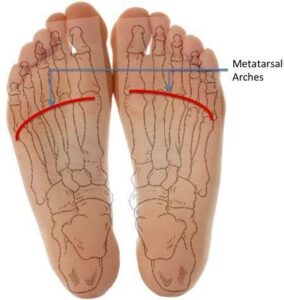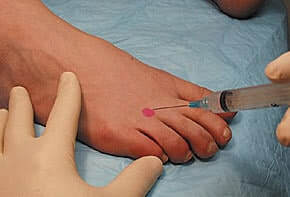Morton’s neuroma is a clinical condition where there is thickening of the sheath of the plantar interdigital nerve within the foot which often results in irritation and pain, commonly between the third and the fourth toes. It has many other names as well, such as plantar neuroma and Morton’s metatarsalgia. The treatments of Morton’s neuroma are many, all of them having varying levels of effectiveness.
In this article, we shall take a look at the role of orthotics and corticosteroid injections in the treatment of Morton’s neuroma. (One should note however, that for early stage Morton’s neuroma, orthotics and corticosteroid injections should be combined with physical therapy and modification of shoes.)
Orthotics refers to specific devices that can help alter a posture in order to relieve a musculoskeletal problem. In Morton’s neuroma, the primary symptom that a patient experiences is pain. In the early stages of the condition, targeting this symptom can help maintain a normal quality of life for the patient.
Orthotic devices in Morton’s neuroma treatment typically prevent the rolling in of the transverse arch of the foot that is located in the ball of the foot (the “Metatarsal Arch”) when walking. The rolling together of the bones of this arch is responsible for compression of the nerve and the subsequent pain.
Metatarsal arch pads are a commonly prescribed orthotic device that is available over the counter. When used, the pad must be placed under the foot, just before the point of maximal pain. This pad helps spread apart the Metatarsal Arch and by doing so, the pressure on the nerve can be relieved and the pain reduced dramatically.

However, it is important to make sure that the pads are placed perfectly and do not move around in the shoe, as incorrect application can make the treatment completely ineffective. Metatarsal pads, although commonly used, are frequently not effective because of the difficulty in placement of the metatarsal pad in the shoe.
Full length orthotics have a much greater chance of success in the treatment of early stage Morton’s neuroma. Unlike metatarsal pads, they do not move around in the shoe. One must be especially careful that the particular orthotic chosen provides good firm support and contain an adequate and correctly positioned metatarsal pad. It is possible to use off the shelf orthotics for Morton’s neuroma and achieve good pain relief. Newer off the shelf orthotics can be molded and thus customized by a correctly trained professional.
For a truly correctly fitted orthotic, a referral to a specialist orthotist may be needed to custom make the perfect fitting orthotic. The use of custom made foot orthotics is often recommended in the treatment of Morton’s neuroma, and evidence from studies suggests that more than 6 out of 10 patients will obtain a significant benefit in early stage Morton’s neuroma. Detailed analysis of foot movement must be conducted prior to making these devices. Foot molds are taken and orthotic devices are then manufactured by specialized trained orthotists. The ultimate goal is to reduce the stress on the Metatarsal arch, which in turn reduces irritation of the planter inter-digital nerves.
To find out more information about our custom orthotics CLICK HERE.

Corticosteroids are powerful anti-inflammatory agents that are widely used in the treatment of various clinical conditions. In Morton’s neuroma, steroid injections play an important role by significantly reducing the inflammation of the nerves and reducing pain.
There are a number of clinical trials looking at the effectiveness of steroid injections in the treatment of Morton’s neuroma.
In general, it appears that combining both orthotics and steroid injections has an additive effect, providing the patient with a greater degree of relief. Injections are made through the under-surface of the foot through the space affected and the corticosteroid isinjected directly onto the affected nerve fiber. An ultrasound device may be used to inject the steroids more accurately.
Pain relief from steroid injections can last up to four to six weeksand in some cases longer, but for most patients, repeat injections are often needed. Of course, it must be remembered that the use of corticosteroid injections in Morton’s neuroma treatment does not necessarily mean that the patient will avoid for procedures in the future.
Morton’s neuroma is a painful condition. Treatment with the use of orthotics and corticosteroid injections has proven beneficial, particularly when used together. However, improvement may only be short lived, and patients may need additional procedures to help relieve the symptoms from Morton’s neuroma completely. Having said that, they can in the interim help improve mobility and quality of life of patients.


By providing us with your information you are consenting to the collection and use of your information in accordance with our Terms of Service and Privacy Policy.